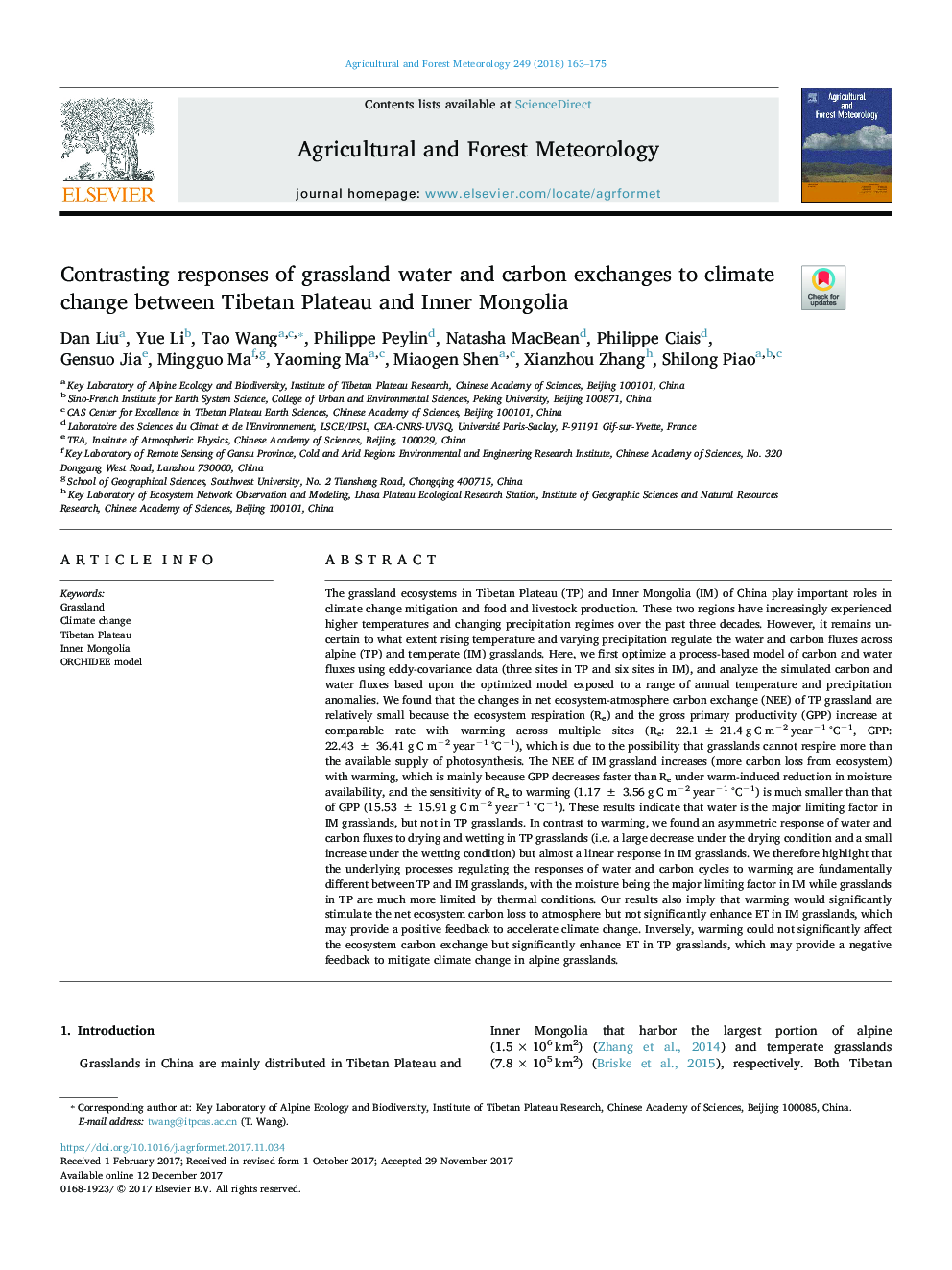| کد مقاله | کد نشریه | سال انتشار | مقاله انگلیسی | نسخه تمام متن |
|---|---|---|---|---|
| 6536841 | 1420852 | 2018 | 13 صفحه PDF | دانلود رایگان |
عنوان انگلیسی مقاله ISI
Contrasting responses of grassland water and carbon exchanges to climate change between Tibetan Plateau and Inner Mongolia
ترجمه فارسی عنوان
پاسخهای متضاد آب و کربن علفی و تبادل کربن به تغییرات آب و هوایی بین افق تبت و مغولستان داخلی
دانلود مقاله + سفارش ترجمه
دانلود مقاله ISI انگلیسی
رایگان برای ایرانیان
کلمات کلیدی
موضوعات مرتبط
مهندسی و علوم پایه
علوم زمین و سیارات
علم هواشناسی
چکیده انگلیسی
The grassland ecosystems in Tibetan Plateau (TP) and Inner Mongolia (IM) of China play important roles in climate change mitigation and food and livestock production. These two regions have increasingly experienced higher temperatures and changing precipitation regimes over the past three decades. However, it remains uncertain to what extent rising temperature and varying precipitation regulate the water and carbon fluxes across alpine (TP) and temperate (IM) grasslands. Here, we first optimize a process-based model of carbon and water fluxes using eddy-covariance data (three sites in TP and six sites in IM), and analyze the simulated carbon and water fluxes based upon the optimized model exposed to a range of annual temperature and precipitation anomalies. We found that the changes in net ecosystem-atmosphere carbon exchange (NEE) of TP grassland are relatively small because the ecosystem respiration (Re) and the gross primary productivity (GPP) increase at comparable rate with warming across multiple sites (Re: 22.1 ± 21.4 g C mâ2 yearâ1 °Câ1, GPP: 22.43 ± 36.41 g C mâ2 yearâ1 °Câ1), which is due to the possibility that grasslands cannot respire more than the available supply of photosynthesis. The NEE of IM grassland increases (more carbon loss from ecosystem) with warming, which is mainly because GPP decreases faster than Re under warm-induced reduction in moisture availability, and the sensitivity of Re to warming (1.17 ± 3.56 g C mâ2 yearâ1 °Câ1) is much smaller than that of GPP (15.53 ± 15.91 g C mâ2 yearâ1 °Câ1). These results indicate that water is the major limiting factor in IM grasslands, but not in TP grasslands. In contrast to warming, we found an asymmetric response of water and carbon fluxes to drying and wetting in TP grasslands (i.e. a large decrease under the drying condition and a small increase under the wetting condition) but almost a linear response in IM grasslands. We therefore highlight that the underlying processes regulating the responses of water and carbon cycles to warming are fundamentally different between TP and IM grasslands, with the moisture being the major limiting factor in IM while grasslands in TP are much more limited by thermal conditions. Our results also imply that warming would significantly stimulate the net ecosystem carbon loss to atmosphere but not significantly enhance ET in IM grasslands, which may provide a positive feedback to accelerate climate change. Inversely, warming could not significantly affect the ecosystem carbon exchange but significantly enhance ET in TP grasslands, which may provide a negative feedback to mitigate climate change in alpine grasslands.
ناشر
Database: Elsevier - ScienceDirect (ساینس دایرکت)
Journal: Agricultural and Forest Meteorology - Volume 249, 15 February 2018, Pages 163-175
Journal: Agricultural and Forest Meteorology - Volume 249, 15 February 2018, Pages 163-175
نویسندگان
Dan Liu, Yue Li, Tao Wang, Philippe Peylin, Natasha MacBean, Philippe Ciais, Gensuo Jia, Mingguo Ma, Yaoming Ma, Miaogen Shen, Xianzhou Zhang, Shilong Piao,
